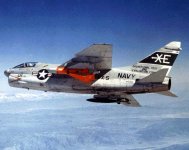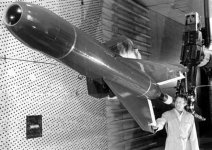




The AGM-62 WALLEYE is a guided glide bomb designed to be delivered on a surface target from an attack aircraft. It is used primarily against targets such as fuel tanks, tunnels, bridges, radar sites, port facilities, and ammunition depots. The weapon system consists of the weapon, the attack aircraft, the AN/AWW-9B data link pod, and the OK-293/AWW control group. The WALLEYE is unique in that it has no propulsion section and must rely on its ability to glide to the target after release from the aircraft.
There are three basic series of the WALLEYE weapon. The original WALLEYE I Extended Range Data Link (ERDL) utilizes a tone data link system while the newer version utilizes the differential phase shift keyed digital data link, designed to prevent signal jamming. The WALLEYE II and WALLEYE II ERDL are greater in diameter, length, and weight than the WALLEYE I ERDL weapons. The AGM- 62 designation for Walleye nomenclature is not in wide use.
China Lake designed and developed the first precision-guided antisurface weapon, the Walleye (AGM-62) TV-guided glide bomb. Related to Walleye but cancelled before completion was Condor (AGM-53), a rocket-powered TV-guided missile. Extended-range data links have also been developed for Walleye. China Lake also developed Bulldog (AGM-83), the first successful laser-guided missile, which was approved for service use in 1974 but cancelled in favor of the Air Force Maverick.
In January 1963 a Walleye television glide bomb, released from a YA-4B, made a direct impact on its target at the Naval Ordnance Test Station, China Lake in the first demonstration of its automatic homing feature. A contract for production of the Walleye television homing glide bomb was issued to the Martin Marietta Corporation in January 1966. An outgrowth of in-house China Lake technology efforts, Walleye was fielded in 1967 and proved its unsurpassed accuracy in combat.
Originally developed by the Navy, the Air Force began Walleye combat tests in Vietnam during August 1967 that achieved excellent results in good visibility against targets that gave a strong contrast and were lightly defended. Later Walleye operations in more demanding conditions were less successful. It continued to be used in Southeast Asia, but due to its operating restrictions, cost, and the appearance of laser-guided bombs (LGB), comprised only a small fraction (6 percent) of the total number of PGMs employed in Vietnam.
The ERDL weapon provides distinct advantages over the standard WALLEYE. With the ERDL version, the added data link permits the weapon to continue to send a video target display from launch of the weapon until target impact. The data link further allows the controlling aircraft to control the weapon in flight and to either retarget or redefine the target aim point. The controlling aircraft can be the launching aircraft or a second aircraft equipped with a data link pod (AN/AWW-9B).
The 1427-1435 MHz band is used for proficiency training using various guided weapon systems. The weapon systems and supporting data links that operate in this band include the AWW-13 Advanced Data Link, used in the Walleye and SLAM. The current Navy inventory includes approximately 200 Walleye and 800 SLAM weapon systems. The loss of this band for missile command operations would render Navy systems more susceptible to jamming and will impair their terminal guidance. Compounding the problem are developmental weapons, such as the Joint Standoff Weapon Unitary (JSOW Unitary), that will use the AWW-13. The AWW-13 requires spectrum for both command and video functions.
Electro-optical [EO] sensors such as used on Walleye depend on both light and optical contrast for target searching and identification. This obviates their use at night and in significantly adverse weather or visual conditions where the line of sight to a target was obscured. The requirement for visual contrast between the target and its immediate surroundings imposed problems during Desert Storm. For Walleye delivery, F/A-18 pilots reported that a target was sometimes indistinguishable from its own shadow. This made it difficult to reliably designate the actual target, rather than its shadow, for a true weapon hit. The the low-light conditions at dawn and dusk often provided insufficient light for the required degree of optical contrast. A "haze penetrator" version of Walleye used low-light optics to see through daytime haze and at dawn and dusk, permitting use in some of the conditions in which other optical systems were limited.
The SLAM is based on the highly successful and reliable Harpoon anti-ship missile, with a Global Positioning System-aided Inertial Navigation System (GPS/INS) for mid-course guidance, and a Maverick imaging infrared sensor and a Walleye data link for precise, �man-in-the-loop� terminal guidance.
Specifications | |

